CHAPTER 22 After reviewing this chapter, you should be able to: 1. Calculate milliliters per hour (mL/hr) 2. Identify the two types of administration tubing 3. Identify from intravenous (IV) tubing packages the drop factor in drops per milliliter (gtt/mL) 4. Calculate IV flow rate in drops per minute (gtt/min) using a formula method and dimensional analysis 5. Calculate IV flow rate in gtt/min using a shortcut method (mL/hr and constant drop factor) 6. Calculate the flow rate for medications ordered IV over a specified time period 7. Calculate infusion times and completion times 8. Recalculate IV flow rates and determine the percentage (%) of increase or decrease A client with an infusion pump is to receive an antibiotic in 50 mL of 0.9% NS over 30 minutes. 1. Think: The pump infuses in mL/hr. When the infusion time is less than an hour, which often occurs when antibiotics are administered, use a ratio and proportion to determine mL/hr. Remember: 1 hr = 60 min. IV flow rates in gtt/min are determined by the type of IV administration tubing. The drop size is regulated by the size of the tubing. (The larger the tubing, the larger the drops.) The first step in calculating IV flow rate is to identify the type of tubing and its calibration. The calibration of the tubing is printed on each IV administration package (Figure 22-1). IV tubing has a drop chamber. The nurse determines the flow rate by adjusting the clamp and observing the drop chamber to count the drops per minute (Figure 22-2). The size of the drop depends on the type of IV tubing used. The calibration of IV tubing in gtt/mL is known as the drop factor and is indicated on the box in which the IV tubing is packaged. This calibration, which is necessary to calculate flow rates, is shown on the packaging of IV administration sets (see Figure 22-1). The two common types of tubing used to administer IV fluids are as follows: Macrodrop is the standard type of tubing used for general IV administration. This type of tubing delivers a certain number of gtt/mL, as specified by the manufacturer. Macrodrop tubing delivers 10, 15, or 20 gtt equal to 1 mL. Macrodrops are large drops; therefore large amounts of fluid are administered in macrodrops (Figure 22-3, A). Microdrop tubing delivers tiny drops, which can be inferred from the prefix micro. It is used when small amounts and more exact measurements are needed, for example, in pediatrics, for the elderly, and in critical care settings. Microdrop tubing delivers 60 gtt equal to 1 mL. Because there are 60 minutes in an hour, the number of microdrops per minute is equal to the number of mL/hr. For example, if clients are receiving 100 mL/hr, they are receiving 100 microdrops/min (see Figure 22-3, B). Figure 22-4 shows a comparison of calibrated drops. Before calculating, let’s review some basic principles: 1. Drops per minute are always expressed in whole numbers. You cannot regulate something at a half of a drop. Because drops are expressed in whole numbers, principles of rounding off are applied; for example, 19.5 gtt = 20 gtt. 2. Carry division of the problem one decimal place to round to a whole number of drops. 3. Answers must be labeled. The label is usually drops per minute unless otherwise specified. Examples: 100 gtt/min or 17 gtt/min. To reinforce the differences in drop factor, the type of tubing is sometimes included as part of the label. Examples: 100 microgtt/min or 17 macrogtt/min. Let’s look at some sample problems and a step-by-step method of using the formula to obtain answers. 1. Set up the problem, placing the information given in the correct position in the formula. 2. Reduce where possible to make numbers smaller and easier to manage. Note that the labels are dropped when starting to perform mathematical steps. 3. Divide 100/6 to obtain rate in gtt/min. Carry division one decimal place and round off to the nearest whole number. 1. You are calculating gtt/min, so write gtt/min to the left of the equation, followed by the equals sign (=), and label gtt/min x, since that is what you’re looking for: 2. Extract the information that contains gtt from the problem; the drop factor is 10 gtt/1 mL. Write this factor into the equation, placing gtt in the numerator. 3. The next fraction is written so that the denominator matches the previous fraction (what you are looking for). Go back to the problem and you will see that the order is to infuse 100 mL in 1 hr. Enter the 1 hr as 60 min in the denominator because you are calculating gtt/min (100 mL/60 min). 4. Now that you have the completed equation, cancel the units and notice that you are left with the desired gtt/min. 1. You are calculating gtt/min, so write gtt/min to the left of the equation, followed by the equals sign (=), and label gtt/min x, since that is what you’re looking for: 2. Extract the information that contains gtt from the problem; the drop factor is 60 gtt/1 mL. Write this factor into the equation, placing gtt in the numerator. 3. The next fraction is written so that the denominator matches the previous fraction (what you are looking for). Go back to the problem and you will see that the order is to infuse 50 mL in 20 minutes. Enter the third fraction so that 50 mL is in the numerator and 20 minutes is in the denominator. 4. Now that you have the completed equation, cancel the units and notice that you are left with the desired gtt/min. To use this method you must know the drop factor constant for the administration set you are using. The drop factor constant is sometimes referred to as the division factor. To obtain the drop factor constant (division factor) for the IV administration set being used, divide 60 by the drop factor calibration. Box 22-1 shows the constant calculated based on the drop factor for the tubing. Administer 0.9% NS at 75 mL/hr. The drop factor is 60 gtt/mL. The drop factor constant is 1.
Intravenous Calculations
IV FLOW RATE CALCULATION
Calculating Flow Rates for Volumetric Pumps in mL/hr
Example 2:
CALCULATING IV FLOW RATES IN gtt/min
IV TUBING
Macrodrop Tubing
Microdrop Tubing
CALCULATING FLOW RATES IN DROPS PER MINUTE USING A FORMULA
Formula Method

Example 1:



Dimensional Analysis Method
Example 1:



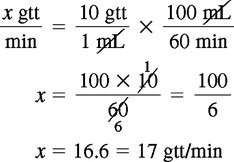
Example 2:



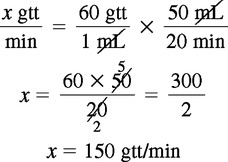
Calculation of IV Flow Rates Using a Shortcut Method
Example 3:


 Solution Using Formula Method
Solution Using Formula Method

 Solution Using Ratio and Proportion
Solution Using Ratio and Proportion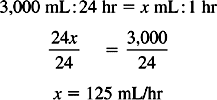

 Solution Using Ratio and Proportion
Solution Using Ratio and Proportion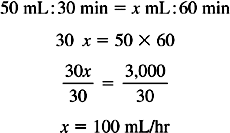

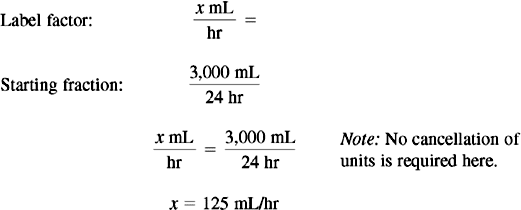

 Practice Problems
Practice Problems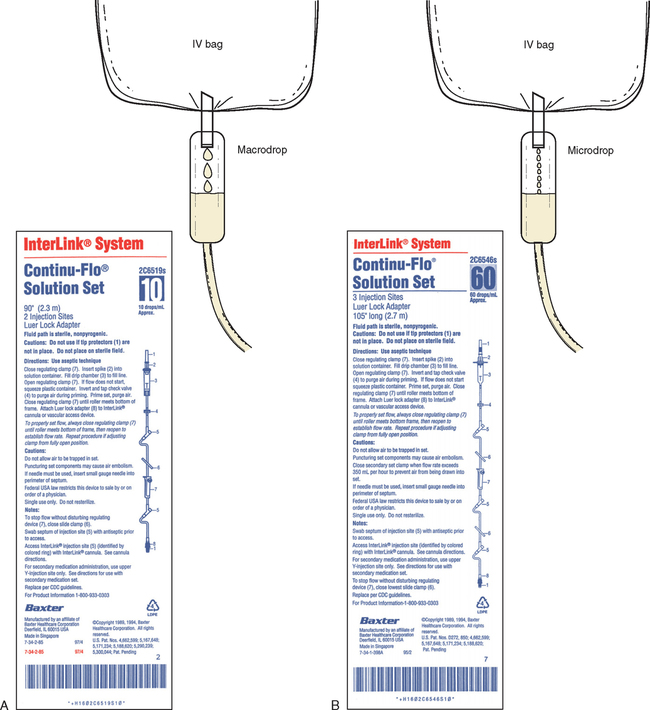
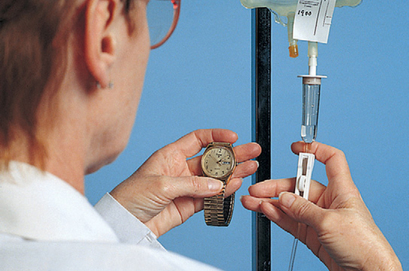
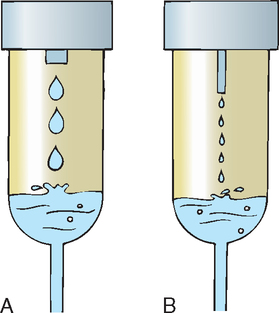
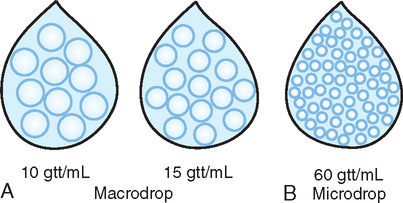
 Practice Problems
Practice Problems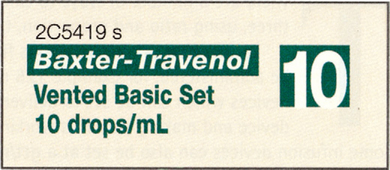

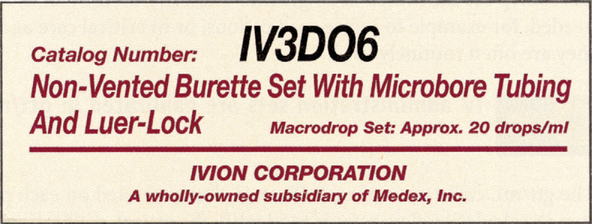


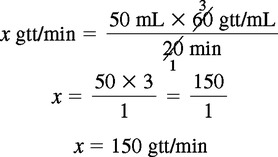

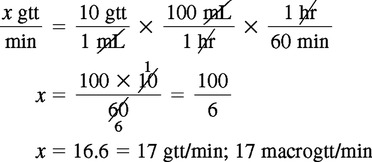

 Solution Using the Formula Method
Solution Using the Formula Method

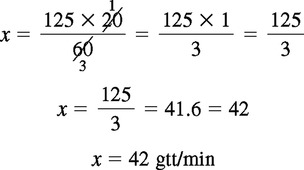
 Solution Using Dimensional Analysis
Solution Using Dimensional Analysis


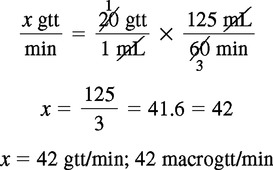

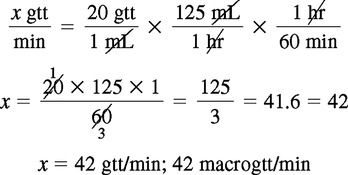

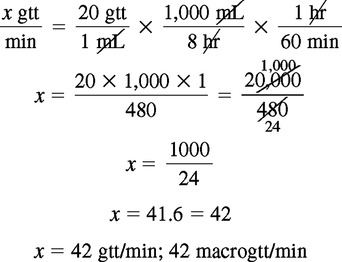
 Solution Using the Formula Method
Solution Using the Formula Method

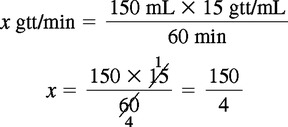

 Solution Using Dimensional Analysis
Solution Using Dimensional Analysis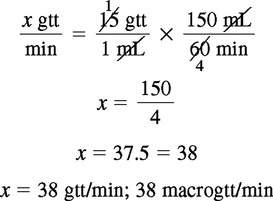
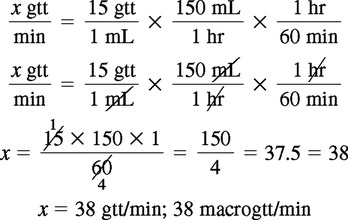
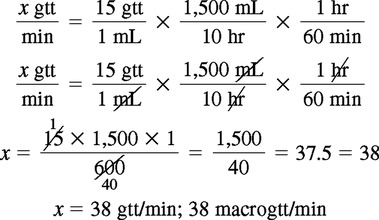
 Practice Problems
Practice Problems





 Practice Problems
Practice Problems Solution Using the Shortcut Method
Solution Using the Shortcut Method
 Solution Using Dimensional Analysis
Solution Using Dimensional Analysis

 Solution Using the Shortcut Method
Solution Using the Shortcut Method
 Solution Using Dimensional Analysis
Solution Using Dimensional Analysis
 Solution Using the Shortcut Method
Solution Using the Shortcut Method Solution Using Dimensional Analysis
Solution Using Dimensional Analysis
 Practice Problems
Practice Problems


